By Steve Keen
This piece is part of a series from Steve Keen, Climate Change and the Nobel Prize in Economics: The Age of Rebellion. From the previous post:
- William Nordhaus of The Breakthrough Institute recently won the Nobel Prize in Economics based on his work on climate change.
- Extinction Rebellion, a UK-based youth movement, is demanding policies that would cause net zero carbon emissions by 2025 and limiting global warming to no more than 1.5 degrees.
- William Nordhaus’ research encourages policy makers to manage global climate so it stabilizes at 4 degrees by the mid 22nd century.
- Nordhaus’ research also argues that limiting global warming to 1.5 degrees would cost the global economy more than 50 trillion US dollars, while yielding benefits of well under US$5 trillion.
In this post, Keen delves into DICE (“Dynamic Integrated model of Climate and the Economy”)—the mathematical model underpinning Nordhaus’ work and the flaws in Nordhaus’ methodologies.
DICE stands for “Dynamic Integrated model of Climate and the Economy”. It’s the mathematical model from which Nordhaus derives the results noted in the previous figures.
DICE is based on the Neoclassical long term growth model devised by the mathematical prodigy Frank Ramsey in 1928 {Ramsey, 1928 #5029}. This is the same foundation as the mainstream RBC (“Real Business Cycle”) and DSGE (“Dynamic Stochastic General Equilibrium”) macroeconomic models that completely failed to anticipate the 2008 Global Financial Crisis.
That its macroeconomic cousins fared so badly at their chosen task is cause enough for concern. These models were intended to forecast short-term economic growth, and were completely wrong about the immediate economic future, to disastrous effect. That should at least raise some concerns. Was this failure just because the underlying technology was never meant to handle short-term economic dynamics? Or is the underlying Neoclassical growth model itself simply a poor model of reality?
This is a serious issue that I’ll take up in later chapters. However, the features that Nordhaus has added to model Climate Change are far worse than the inadequate foundation on which it was built.
Get Evonomics in your inbox
DICE’s major additions to the standard model are:
- A “damage function” that relates the increase in average global temperature to a decline in GDP. This is the source of the “Future damages” estimates shown in Figure 2 (in the previous post);
- An “abatement function” that calculates the cost of reducing global temperature rise over what would happen if nothing were done to tackle Climate Change. This is the source of “Present abatement” estimates shown in Figure 2; and
- Equations to relate GDP growth to the increase in CO2 levels in the atmosphere, along with the impact of that increased CO2 on the average global temperature.
Many critics have focused upon the high discount rate that Nordhaus chose to apply calculate the value to existing generations of reducing future Global Warming. But by far the most egregious fallacy in Nordhaus’s model is its Damage Function.
Nordhaus’s Damage Function is the first substantive graphic in the DICE manual, and one look at it (see Figure 8) should give anyone—even Climate Change Deniers (CCDs)—cause for concern. Even if Anthropogenic Global Warming were a myth, even if the temperature rise was being caused by the Sun, would it really be true that a 5 degree increase in the average temperature of the globe would only reduce global GDP by 5 percent?
Figure 3: Nordhaus’s Damage Function, showing the estimated reduction in GDP for an increase in global mean temperature
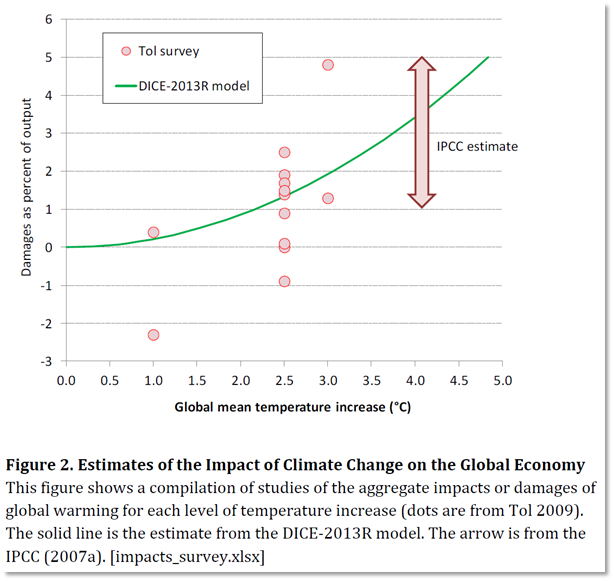
This is not, as is sometimes believed, the result of Nordhaus applying a high discount rate to the impact of climate change in the distant future. This instead is his estimate of how much lower global GDP would be in the future—say, 130 years from now—compared to what it would have been, if temperatures had instead remained at pre-industrial levels. Given the urgency that characterises the Global Warming debate, this is, on the face of it, an extremely benign view of the impact of an increase in the global average temperature on GDP.
He reiterated this benign view in a 2017 paper, “Revisiting the social cost of carbon” {Nordhaus, 2017 #5559}:
Including all factors, the final estimate is that the damages are 2.1% of global income at a 3 °C warming, and 8.5% of income at a 6 °C warming. {Nordhaus, 2017 #5559, p. 1519}
If the predictions of Nordhaus’s Damage Function were true, then everyone—including Climate Change Believers (CCBs)—should just relax. An 8.5 percent fall in GDP is twice as bad as the “Great Recession”, as Americans call the 2008 crisis, which reduced real GDP by 4.2% peak to trough. But that happened in just under two years, so the annual decline in GDP was a very noticeable 2%. The 8.5% decline that Nordhaus predicts from a 6 degree increase in average global temperature (here CCDs will have to pretend that AGW is real) would take 130 years if nothing were done to attenuate Climate Change, according to Nordhaus’s model (see Figure 1). Spread over more than a century, that 8.5% fall would mean a decline in GDP growth of less than 0.1% per year. At the accuracy with which change in GDP is measured, that’s little better than rounding error. We should all just sit back and enjoy the extra warmth.
Except those in New York, London, Sydney, Cape Town, Los Angeles, San Francisco, and numerous other coastal cities of course, because they be too busy moving to higher ground: 6 degrees is well above the threshold at which all of Greenland and the Antarctic will melt completely (even if it’s the Sun’s fault, rather than AGW). That will take much more than a century of course, but a planetary temperature rise of 6 degrees will doom any city less than 70 metres above sea level. They will all have to be relocated and rebuilt.
Human settlements closer to the Equator that are well above sea level will be safe from rising sea waters, but they will also be on the move: a 6 degree increase in temperature will make many of them unliveable. The obvious suspects—the Middle East and Northern Africa—would see average summer temperatures of over 40 degrees in their major cities, and much of their countryside. Moving them, or emigrating from them, would be essential for survival (see Figure 4 and Figure 5).
So all this human movement, and all this city rebuilding, plus everything else that a 6 degree rise in temperature (however it was caused) would trigger, will only reduce global GDP by 8.5%? This claim fails what Robert Solow appropriately christened “the smell test” {Solow, 2010 #5078, p. 12}: if an economic model returns a prediction like this, it has to be … fill in your favourite expletive here.
Figure 4: Cities in Africa whose average summer temperatures today exceed 34 degrees for at least one month
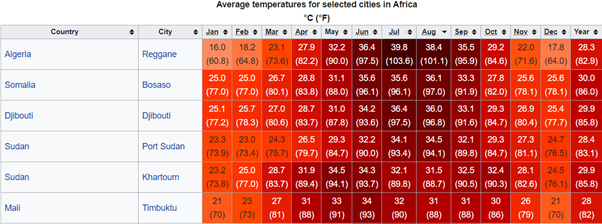
Figure 5: Cities in Asia/Middle East whose average summer temperatures today exceed 34 degrees for at least one month
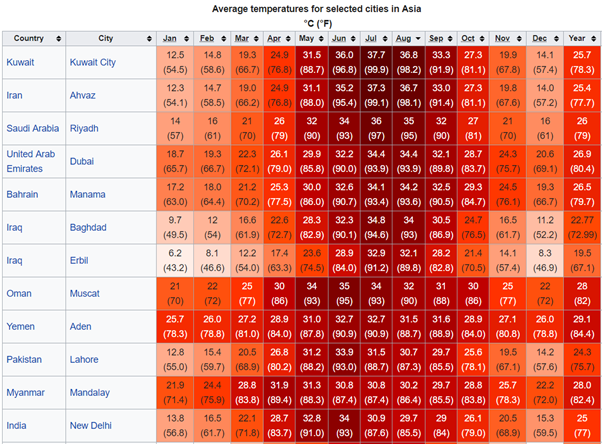
It doesn’t take long to find the sources of [expletive deleted] in Nordhaus’s model. There are several, but the most egregious of all is the mathematical form of his “Damage Function”.
Mostly Harmless
With all the obvious complexities and uncertainties in the whole issue of how climate interacts with the economy and vice versa, Nordhaus chose to use the second-simplest relationship possible between two variables: a quadratic. He simply assumes that the relationship between change in global temperature (relative to the level in 1900) and reduction in GDP is a function of the temperature difference squared:
“The current version assumes that damages are a quadratic function of temperature change” {Nordhaus, 2013 #5673, p. 11}
His estimate of the damages to GDP from an increase in temperature over pre-industrial levels is shown in Equation
and Figure 6.

Figure 6: The parameters for Nordhaus’s estimate of damage from temperature change in the code for his DICE model

One property of a quadratic is that there are no discontinuities, and therefore no points at which the relationship implied by the function simply breaks down. In the context of modelling climate change, using a quadratic for the relationship between an increase in global temperature and the economy implies that there are no temperature levels that set off catastrophic breakdown in the economy by triggering fundamental qualitative shifts in the climate—such as melting the icecaps, stopping the Gulf Stream, or turning El Nino from a temporary phenomenon into a permanent one. Nordhaus acknowledges this in the same sentence, and justifies the absence of such a feature in his Damage Function by an appeal to a survey of actual climate scientists about whether there are tipping points in the climate:
The current version assumes that damages are a quadratic function of temperature change and does not include sharp thresholds or tipping points, but this is consistent with the survey by Lenton et al. (2008).” {Nordhaus, 2013 #5673, p. 11}
So climate scientists concurred that there are no “sharp thresholds or tipping points” in the climate—or at least, in the relationship between temperature increase and the economy? I wanted to see evidence of that. I expected a detailed exposition of this research, since this assertion is crucial to Nordhaus’s choice of a simple quadratic to model economic damages from climate change.
I was disappointed. Not only was there no further explanation, there was no reference for Lenton in his bibliography either. Fortunately, the paper (Lenton, T. M., H. Held, et al. (2008). “Tipping elements in the Earth’s climate system.” Proceedings of the National Academy of Sciences
105(6): 1786-1793) can be found online {Lenton, 2008 #5678}. Since this paper played a key role in Nordhaus’s justification of his simple damage equation, I decided to check it very carefully—something Nordhaus himself quite obviously did not do.
There is one sentence in this paper, and only one sentence (in the paper’s third paragraph), which could be construed to support Nordhaus’s interpretation that the absence of “sharp thresholds or tipping points” in his Damage Function is “consistent with the survey by Lenton”. It is the statement that:
Many of the systems we consider do not yet have convincingly established tipping points. {Lenton, 2008 #5678, p. 1786}
However, the point of the paper was to try to quantify those tipping points—not to argue that they don’t exist! The very next sentence makes this obvious:
Nevertheless, increasing political demand to define and justify binding temperature targets, as well as wider societal interest in nonlinear climate changes, makes it timely to review potential tipping elements in the climate system under anthropogenic forcing. {Lenton, 2008 #5678, p. 1786}
The remainder of the paragraph confirms that the purpose of the survey was to provide what was currently missing (” convincingly established tipping points”), not to decide whether tipping points exist or not and conclude in the negative:
To this end, we organized a workshop entitled ”Tipping Points in the Earth System” at the British Embassy, Berlin, which brought together 36 leading experts, and we conducted an expert elicitation that involved 52 members of the international scientific community. Here we combine a critical review of the literature with the results of the workshop to compile a short list of potential policy-relevant future tipping elements in the climate system. Results from the expert elicitation are used to rank a subset of these tipping elements in terms of their sensitivity to global warming and the associated uncertainty. {Lenton, 2008 #5678, p. 1786. Emphasis added}
Far from justifying the absence of “tipping points” in any model of the relationship between the economy and global warming, the paper asserts that tipping points exist, and pretending that they don’t exist, via “smooth projections of global change”, could, rather than providing a sensible guide to policy, lull society “into a false sense of security”:
Society may be lulled into a false sense of security by smooth projections of global change. Our synthesis of present knowledge suggests that a variety of tipping elements could reach their critical point within this century under anthropogenic climate change. The greatest threats are tipping the Arctic sea-ice and the Greenland ice sheet, and at least five other elements could surprise us by exhibiting a nearby tipping point. This knowledge should influence climate policy… {Lenton, 2008 #5678, p. 1792. Emphasis added}
The survey restricted itself to large components of the Earth’s biosphere, with tipping points that could occur in this century, and whose effects would be felt within this millennium:
We consider ”components” of the Earth system that are associated with a specific region (or collection of regions) of the globe and are at least subcontinental in scale (length scale of order 1,000 km)… we focus on the consequences of decisions enacted within this century that trigger a qualitative change within this millennium, and we exclude tipping elements whose fate is decided after 2100 {Lenton, 2008 #5678, pp. 1786-87}.
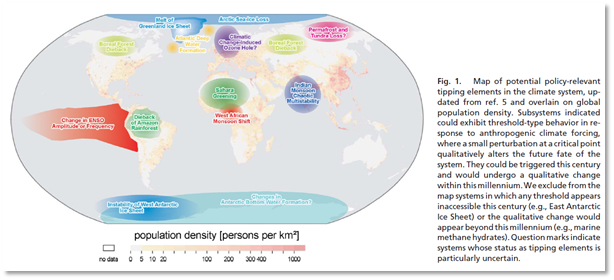
Figure 7: The systems with tipping points considered in Lenton’s survey
Contrary to Nordhaus’s claim that Lenton’s work supported the exclusion of tipping points from his Damage Function, Lenton’s survey concluded that there were two tipping points that had a high probability of being triggered this century (Arctic sea ice and Greenland’s ice sheet), and five more that might be triggered:
Our synthesis of present knowledge suggests that a variety of tipping elements could reach their critical point within this century under anthropogenic climate change. The greatest threats are tipping the Arctic sea-ice and the Greenland ice sheet, and at least five other elements could surprise us by exhibiting a nearby tipping point. {Lenton, 2008 #5678, pp. 1792. Emphasis added.}
So the very reference that Nordhaus uses to justify not having a tipping point in his Damage Function establishes that his Damage Function should have a tipping point.
Nordhaus does at least express a caveat or three about the simplistic, and clearly unjustified function he used for his model:
I would note an important warning about the functional form in equation (5) when using for large temperature increases. The damage function has been calibrated for damage estimates in the range of 0 to 3 °C. In reality, estimates of damage functions are virtually non-existent for temperature increases above 3 °C. Note also that the functional form in (5), which puts the damage ratio in the denominator, is designed to ensure that damages do not exceed 100% of output, and this limits the usefulness of this approach for catastrophic climate change. The damage function needs to be examined carefully or re-specified in cases of higher warming or catastrophic damages. {Nordhaus, 2013 #5673, p. 11}
Paraphrasing this, “if there aren’t tipping points in the global climate, then you can use my model to guide policy; but if there are, you’re on your own”. That’s about as useful as a car without a steering wheel. It will work fine if you’re on a straight road, but if the road bends, you’re dead. And Climate Change is the ultimate “long and windy road”.
That might sound harsh—and it is. But justifiably so. We use models to guide us in situations that we have not yet encountered, or in which we have made policy mistakes in the past. It is no defence of a model to say—after the catastrophe that it said couldn’t happen did happen—that it was only designed for situations in which catastrophes didn’t occur. Ironically, that is precisely the defence that Ben Bernanke made of mainstream macroeconomic models after the 2008 financial crisis:
Although economists have much to learn from this crisis, as I will discuss, I think that calls for a radical reworking of the field go too far… Economic models are useful only in the context for which they are designed. Most of the time, including during recessions, serious financial instability is not an issue. The standard models were designed for these non-crisis periods, and they have proven quite useful in that context. {Bernanke, 2010 #1474}
That is a fob-off, not a justification for models that only work during “non-crisis periods”. A model that only applies in conditions where it is not needed, when you don’t have an alternative when it is needed, is worse than useless. It, as Lenton’s paper stated, lulls you “into a false sense of security”, which evaporates catastrophically when the actual catastrophe strikes.
With macroeconomics itself, such useless models let the world walk blindfolded into the biggest economic crisis since the Great Depression. However painful that crisis was, it will be nothing on the ecological and economy calamities that will occur if any of the tipping points noted by the “the survey by Lenton” are actually triggered.
This can easily be illustrated by replacing Nordhaus’s quadratic with a very similar one that does have tipping points: a “rational function“. This is a fraction with one polynomial divided by another. Since Nordhaus’s function is just a square of the (difference in) temperature, the required function has a constant times temperature to the third power on the numerator, and a linear function of temperature on the denominator.
For the denominator, since even Nordhaus predicts that “business as usual” would lead to a 4 degree increase in temperature by 2100 (see his “base” plot in Figure 1), and Lenton’s survey says the projected temperature increase this century could trigger at least two planetary tipping points, it’s reasonable to use 4 degrees as the tipping point temperature.
The only problem left is to choose a value for the constant multiplying the cube of the temperature increase on the numerator. I’ve set it so that this function and Nordhaus’s return the same level of damage for the only real data point we have: the 1 degree increase in temperature over pre-industrial levels that we have already experienced. Since Nordhaus’s latest DICE model uses a value of 0.00236 for the constant, the constant in this rational function has the value of minus three times Nordhaus’s coefficient. The damage equation with a tipping point is thus:

This makes an enormous difference to the implied damage to GDP from rising temperature levels. Contrary to Nordhaus’s assertion that caution is needed “when using [his model] for large temperature increases”, his model is unreliable for temperatures that are well within the levels on which he has made pronouncements about what global warming will do to GDP. Even at just a 1.5 degree increase—the level that Extinction Rebellion wants politicians to set as a maximum—the estimate of damages are almost twice Nordhaus’s estimate (see Table 1)
Table 1: Damages from a 4-degree tipping point versus Nordhaus’s quadratic function

At higher temperatures, but ones which are still well within the range over which Nordhaus deigns to make predictions, the disparity is even more marked. The 4-degree tipping point estimate of damage is 2.7% of GDP for a 2 degree rise—three times Nordhaus’s estimate. At 3 degrees, damages are 8 times as high. At 4 degrees, the ratio doesn’t matter, because the tipping point function says there would be no economy—versus Nordhaus’s prediction of a mere 3.6% decline over what it would have been in the absence of any change in temperature.
Figure 8: Nordhaus’ Damage Function versus one based on a 4-degree tipping point function
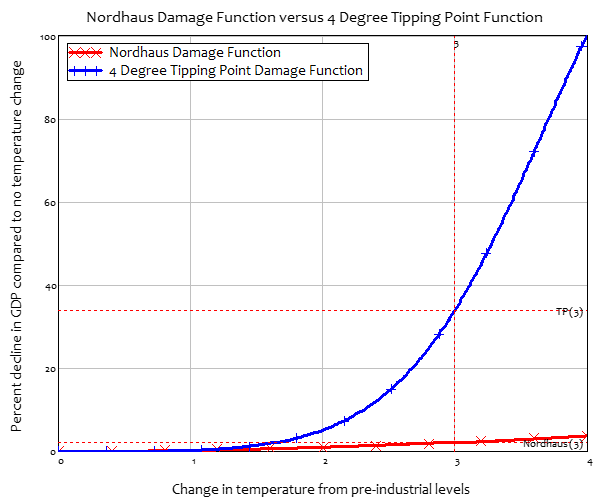
This alone is enough to reject outright Nordhaus’s assurances about the manageability of climate change. Nordhaus has put the world into a Dirty Harry movie gone bad: having advised policymakers that a simple and low tax on carbon is a Magnum 44 for shooting climate change, they scoff at the danger, telling climate change “‘Do you feel lucky, punk?”. In reality, climate change is armed with a howitzer, and the policy Nordhaus recommends—letting the global temperature reach levels 4 degrees above pre-industrial levels—would unleash that howitzer.
But what about the data to which Nordhaus fitted his inappropriate function? Doesn’t that imply that 4 degrees isn’t so dangerous?
Read more from Steve Keen on Patreon.
2019 July 14
Donating = Changing Economics. And Changing the World.
Evonomics is free, it’s a labor of love, and it's an expense. We spend hundreds of hours and lots of dollars each month creating, curating, and promoting content that drives the next evolution of economics. If you're like us — if you think there’s a key leverage point here for making the world a better place — please consider donating. We’ll use your donation to deliver even more game-changing content, and to spread the word about that content to influential thinkers far and wide.
MONTHLY DONATION
$3 / month
$7 / month
$10 / month
$25 / month
You can also become a one-time patron with a single donation in any amount.
If you liked this article, you'll also like these other Evonomics articles...
BE INVOLVED
We welcome you to take part in the next evolution of economics. Sign up now to be kept in the loop!
























